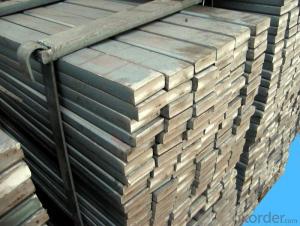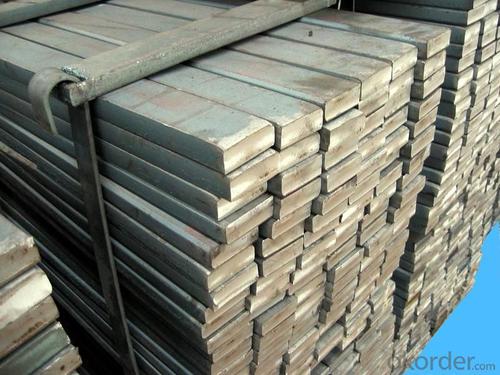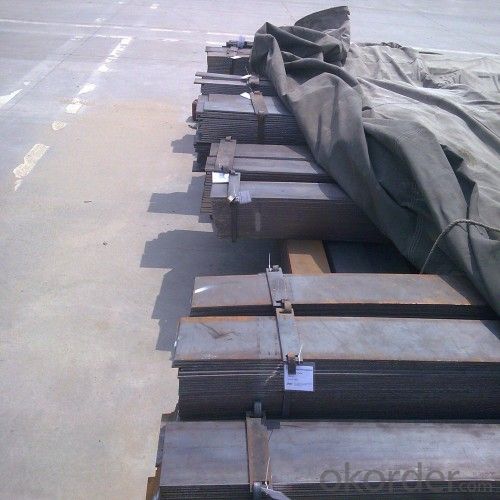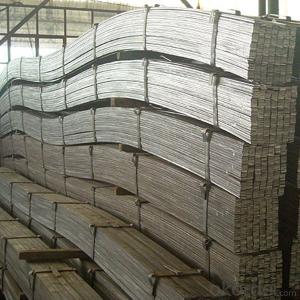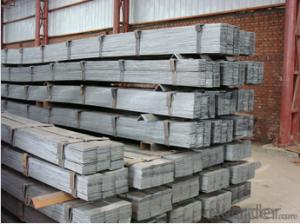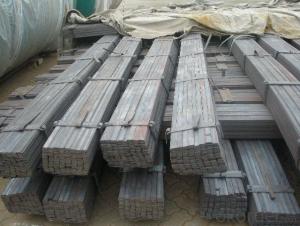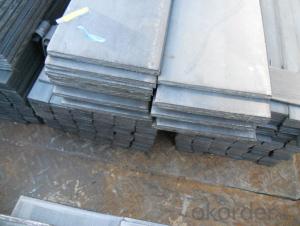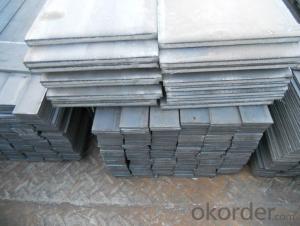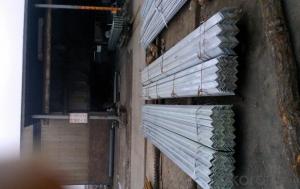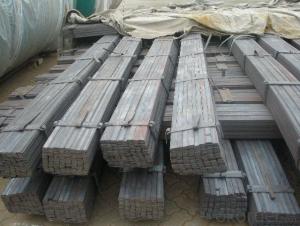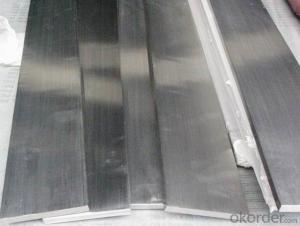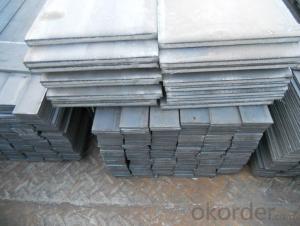Hot Rolled Flat Bars with Material Good Price
- Loading Port:
- Tianjin
- Payment Terms:
- TT OR LC
- Min Order Qty:
- 25 m.t
- Supply Capability:
- 10000 m.t/month
OKorder Service Pledge
OKorder Financial Service
You Might Also Like
Product Description:
OKorder is offering high quality Flat Bar at great prices with worldwide shipping. Our supplier is a world-class manufacturer of steel, with our products utilized the world over. OKorder annually supplies products to European, North American and Asian markets. We provide quotations within 24 hours of receiving an inquiry and guarantee competitive prices.
Product Applications:
Flat Bars are ideal for structural applications and are widely used in the construction of buildings and bridges, and the manufacturing, petrochemical, and transportation industries.
Product Advantages:
OKorder's Flats Barare durable, strong, and resist corrosion.
Main Product Features:
· Premium quality
· Prompt delivery & seaworthy packing (30 days after receiving deposit)
· Corrosion resistance
· Can be recycled and reused
· Mill test certification
· Professional Service
· Competitive pricing
Product Specifications:
Manufacture: Hot Rolled
Grade: Q195 – 235
Certificates: ISO, SGS, BV, CIQ
Length: 6m – 12m, as per customer request
Packaging: Export packing, nude packing, bundled
Chemical composition of Q235
Alloy No | Grade | Element(%) | ||||
C
| Mn
| S
| P
| Si
| ||
Q235
|
B
|
0.12—0.20 |
0.3—0.7 |
≤0.045 |
≤0.045
|
≤0.3
|
Physical properties of Q235
Alloy No | Grade | Yielding strength point(Mpa) | Tensile strength (Mpa) | Elongation after fracture(%) | ||||||
Thickness (mm) | Thickness (mm) | |||||||||
≤16 | >16--40 | >40--60 | >60--100 | ≤16 | >16--40 | >40--60 | >60--100 | |||
≥ | ≥ | |||||||||
Q235 |
B |
235 |
225 |
215 |
205 |
375--500 |
26 |
25 |
24 |
23 |
FAQ:
Q1: Why buy Materials & Equipment from OKorder.com?
A1: All products offered byOKorder.com are carefully selected from China's most reliable manufacturing enterprises. Through its ISO certifications, OKorder.com adheres to the highest standards and a commitment to supply chain safety and customer satisfaction.
Q2: How do we guarantee the quality of our products?
A2: We have established an advanced quality management system which conducts strict quality tests at every step, from raw materials to the final product. At the same time, we provide extensive follow-up service assurances as required.
Q3: How soon can we receive the product after purchase?
A3: Within three days of placing an order, we will begin production. The specific shipping date is dependent upon international and government factors, but is typically 7 to 10 workdays.
Images:

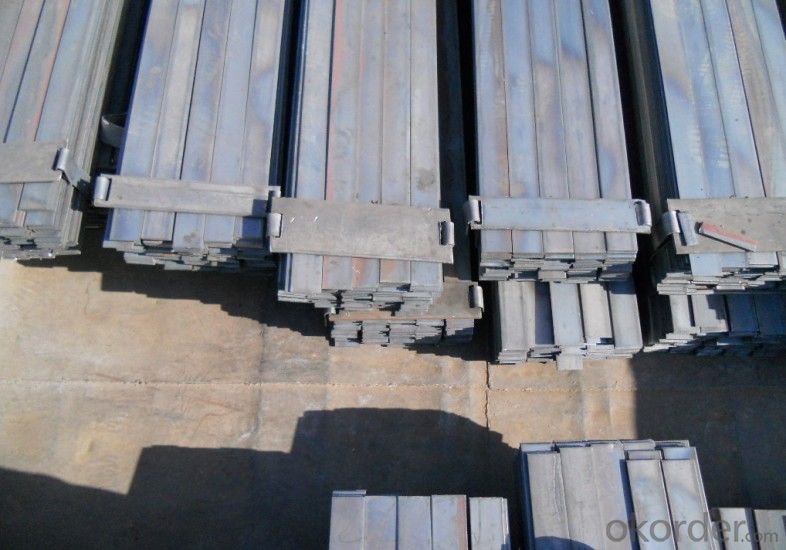
- Q: Are steel flat bars suitable for machining processes?
- Yes, steel flat bars are suitable for machining processes. Steel flat bars are typically made from low-carbon steel, which is known for its excellent machinability. This means that it can be easily cut, drilled, and shaped using various machining techniques, such as milling, turning, or grinding. Additionally, steel is a durable and strong material, making it ideal for machining applications that require high precision and tight tolerances. However, it is important to note that the specific grade and composition of the steel flat bar may affect its machinability. Different grades of steel may have different hardness, toughness, and other properties, which can impact the machining process. Therefore, it is recommended to consult the manufacturer's guidelines or seek professional advice to ensure the suitability of steel flat bars for specific machining processes.
- Q: Can steel flat bars be used for making stair treads or steps?
- Yes, steel flat bars can be used for making stair treads or steps. Steel is a strong and durable material that can provide stability and support for staircases. Flat bars can be easily fabricated and shaped to create treads or steps that are both functional and aesthetically pleasing. Additionally, steel's resistance to corrosion makes it suitable for outdoor or high-traffic areas where stairs are commonly found. However, it is important to consider the thickness and dimensions of the steel flat bars to ensure they can withstand the expected load and meet the necessary safety standards.
- Q: Do steel flat bars have a specific tolerance range?
- Yes, steel flat bars do have a specific tolerance range. Tolerance refers to the acceptable deviation from the specified dimensions or properties of a product. In the case of steel flat bars, the tolerance range typically includes variations in thickness, width, and length. The specific tolerance range may vary depending on the manufacturing standards, grade of steel, and intended application of the flat bars. These tolerances are important to ensure the flat bars meet the required specifications and can be effectively used in various construction and industrial applications.
- Q: How do steel flat bars compare to copper flat bars?
- Steel flat bars and copper flat bars are both versatile and widely used in various industries. However, they differ significantly in terms of their properties and applications. Firstly, steel flat bars are typically stronger and more durable than copper flat bars. Steel has a higher tensile strength and hardness, making it ideal for applications that require load-bearing and structural support. It can withstand heavy loads, making it suitable for construction, manufacturing, and automotive industries. On the other hand, copper flat bars are relatively softer and more malleable, making them better suited for electrical applications, such as wiring and circuitry. Secondly, steel flat bars have excellent corrosion resistance, especially when coated with protective materials like galvanized or stainless steel. This makes them suitable for outdoor applications where exposure to moisture, chemicals, and harsh weather conditions is expected. Copper, on the other hand, is naturally corrosion-resistant and forms a protective oxide layer, making it ideal for plumbing, electrical, and marine applications. Another notable difference is their thermal conductivity. Copper is an excellent conductor of heat and electricity, making it widely used in electrical wiring and heat exchangers. Steel, although not as efficient in conducting heat and electricity as copper, still possesses moderate thermal conductivity and finds applications in heating systems and heat transfer equipment. Furthermore, steel flat bars are generally more cost-effective compared to copper flat bars. Steel is abundantly available, making it less expensive than copper, which is a relatively scarce resource. This cost difference is one of the main reasons why steel is more commonly used in construction and manufacturing industries. In summary, steel flat bars are known for their strength, durability, corrosion resistance, and cost-effectiveness. They are commonly used in load-bearing applications and outdoor environments. Copper flat bars, on the other hand, are softer, more malleable, and possess excellent electrical conductivity. They are widely used in electrical and plumbing applications. Ultimately, the choice between steel and copper flat bars depends on the specific requirements of the application at hand.
- Q: Can steel flat bars be used for structural support?
- Indeed, structural support can be provided by steel flat bars. In construction and engineering projects, steel flat bars are frequently utilized to ensure structural support, particularly in situations that demand exceptional strength and durability. They are commonly employed as beams, braces, or supports in various structures such as buildings, bridges, and more. Steel flat bars exhibit remarkable load-bearing capabilities and can endure substantial loads and forces, rendering them ideal for structural support. Moreover, the ease of welding or bolting steel flat bars together enables the creation of larger structural components, thereby offering flexibility in design and construction.
- Q: Can steel flat bars be galvanized or coated with zinc?
- Indeed, it is possible to galvanize or coat steel flat bars with zinc. Galvanization or zinc coating serves as a prevalent technique for safeguarding steel against corrosion. This procedure entails submerging the steel in a molten zinc bath or applying a zinc coating onto its surface. Consequently, a protective layer of zinc forms, serving as a barrier against rust and other types of corrosion. Due to their increased durability and resistance to corrosion, galvanized steel flat bars find extensive application in multiple sectors, including construction, infrastructure, and manufacturing.
- Q: How is steel flat bar manufactured?
- Steel flat bars are typically manufactured through a process known as hot rolling. This involves heating a steel billet to high temperatures and then passing it through a series of rolling mills to achieve the desired thickness and surface finish. The hot rolling process helps to refine the grain structure of the steel, making it stronger and more durable. Once the desired dimensions are achieved, the flat bars are cooled and cut into the required lengths.
- Q: How do you prevent scaling or oxidation on steel flat bars during heat treatment?
- To prevent scaling or oxidation on steel flat bars during heat treatment, several measures can be taken: 1. Use a protective atmosphere: One effective method is to heat treat the steel flat bars in a controlled atmosphere such as a vacuum or an inert gas environment like nitrogen or argon. This prevents the steel from coming into contact with oxygen, thereby minimizing the risk of oxidation. 2. Apply a protective coating: Another approach is to apply a protective coating on the surface of the flat bars before heat treatment. This can be done by using various coatings such as ceramic, refractory, or metallic coatings. These coatings act as a barrier between the steel and the surrounding atmosphere, preventing oxidation. 3. Use a reducing atmosphere: Heat treating the steel in a reducing atmosphere, such as hydrogen or a mixture of hydrogen and nitrogen, can also prevent scaling and oxidation. The reducing atmosphere helps to remove any oxygen present and prevents the formation of oxides on the surface of the steel. 4. Control the heating process: Proper control of the heating process is crucial in preventing scaling and oxidation. Rapid heating and cooling rates should be avoided as they can lead to excessive scaling. Slow and controlled heating with proper temperature ramping can help reduce the chances of oxidation. 5. Clean the surface: Prior to heat treatment, it is important to thoroughly clean the surface of the steel flat bars. Any contaminants, such as dirt, grease, or oils, can promote scaling and oxidation. Surface cleaning methods like degreasing, pickling, or mechanical cleaning can be employed to remove these contaminants. By implementing these preventive measures, the risk of scaling or oxidation on steel flat bars during heat treatment can be significantly reduced, ensuring a high-quality final product.
- Q: How can steel flat bars be protected from rusting?
- Steel flat bars can be protected from rusting through various methods: 1. Coating: Applying a protective coating on the surface of the steel flat bars is one of the most common and effective ways to prevent rusting. There are several types of coatings available, such as paint, powder coating, or galvanizing. These coatings act as a barrier between the steel and moisture in the environment, preventing the formation of rust. 2. Varnishing: Similar to coating, varnishing can provide a protective layer on the steel flat bars. Varnish is often used for decorative purposes, but it can also help in preventing rust by sealing the steel's surface and preventing moisture from coming into contact with it. 3. Oil or Wax: Applying a thin layer of oil or wax on the surface of the steel flat bars can provide protection against rust. The oil or wax acts as a barrier, preventing oxygen and moisture from reaching the steel and causing corrosion. Regular reapplication may be necessary, especially in outdoor or humid environments. 4. Rust Inhibitors: Rust inhibitors are chemical compounds that can be applied to the steel flat bars to prevent rust formation. These inhibitors work by forming a protective layer on the steel's surface or by neutralizing the chemical reactions that lead to rust. They can be applied as a spray, dip, or by adding them to a protective coating. 5. Proper Storage: Storing steel flat bars in a dry and well-ventilated area can help prevent rusting. Moisture is one of the main culprits for rust formation, so keeping the bars away from damp areas or direct contact with water is crucial. Using a dehumidifier or moisture-absorbing packets in storage areas can also help maintain a dry environment. 6. Regular Cleaning and Maintenance: Regularly cleaning the steel flat bars and removing any dirt, dust, or other contaminants can help prevent rust formation. Additionally, inspecting the bars for any signs of rust and promptly addressing the issue can prevent it from spreading and causing further damage. By employing these protective measures, steel flat bars can be effectively shielded from rusting, ensuring their durability and longevity.
- Q: What are the weight and strength properties of steel flat bars?
- The weight and strength properties of steel flat bars vary depending on their specific grade and dimensions. Steel flat bars are widely recognized for their high strength-to-weight ratio, making them a popular choice in multiple industries. The weight of a steel flat bar depends on factors such as length, width, and thickness. The strength properties are determined by the grade of steel used, including mild steel, carbon steel, and alloy steel, each with distinct levels of strength. Furthermore, strength can be further enhanced through processes like heat treatment or cold working. Steel flat bars possess excellent tensile and yield strength, enabling them to withstand heavy loads and resist deformation. They are also highly durable and resistant to corrosion, making them suitable for structural applications, construction projects, and manufacturing processes. In summary, the weight and strength properties of steel flat bars can be tailored to meet specific requirements, making them a versatile and dependable material for a variety of applications.
Send your message to us
Hot Rolled Flat Bars with Material Good Price
- Loading Port:
- Tianjin
- Payment Terms:
- TT OR LC
- Min Order Qty:
- 25 m.t
- Supply Capability:
- 10000 m.t/month
OKorder Service Pledge
OKorder Financial Service
Similar products
Hot products
Hot Searches
Related keywords
